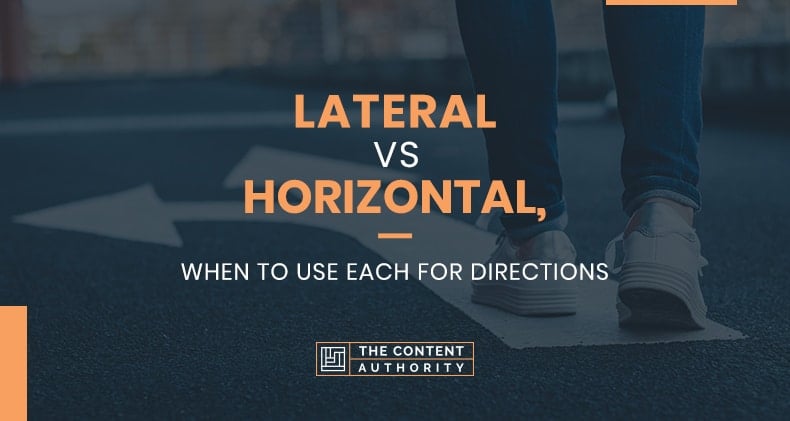If you’ve been asked about a specific location and found yourself between these similar words, how does one know when is the proper occasion to use each? In this article, we will explore what makes them different and when to use each for directions.
Although both seem to reference “next to,” lateral means ‘to the side’ or ‘pertaining to the side,’ while horizontal means’ perpendicular to the vertical’; ‘parallel to the plane of horizon’; ‘level, flat.’ When talking about a street that intersects across another one, the word horizontal should be used. But if we want to remark on an object, structure, or building that is right next to, or to the side of the destination point, we use the word lateral.

Lateral Vs Horizontal
Both are adjectives used to describe the position of something in relationship with another structure, object, or street. In this case, when giving directions, the request must be clear: what is the other person exactly asking for?
- Two lateral tunnels were constructed, so people chose to drive through them for lighter transit.
- We could see the making of a lateral parking lot from far away, apart from the one already made.
- During their tour, Lory and Edward decided to visit the tower’s lateral water canal.
These sentences explain the position of the structures; all three— the tunnels, the parking lot, and the water canal— were located to the side of something else.
For faster use at a moment’s notice, one could replace the word lateral with side, and check if the idea of the sentence is missed or understood.
- Two [side] tunnels were constructed…
- The making of a [side] parking lot…
- Visit the tower’s [side] water canal…
These examples describe the specific spot where the structures were located.
Following up are examples of the correct usage of the word horizontal. Horizontal refers to state – how things are located.
- The map indicated that it was a horizontal pathway rather than a vertical one.
- Do you remember St. Lawrence Street? It is horizontal to Johnson Avenue.
- The Smith National Forest is located on the boulevard horizontal to the town mall.
Origin
The study of etymology is responsible for the vocabulary we use on a day-to-day basis, including positional adjectives, such as lateral and horizontal.
The origin of the word lateral dates back to the 1500s, to old French “latéral,” and from Latin “lateralis,” meaning ‘belonging to the side.’
This term is different from horizontal, which also has roots in old French “horizontal” and Latin “horizontem”; both word roots mean ‘flat’ or ‘parallel to the horizon.’
While one (lateral) is focused on location, closeness to a structure, a building, or at the side of something; the focus of the other term (horizontal) is position.
The problem comes when people try to use both terms interchangeably without knowing they are different and what their proper usage is when giving directions. The decision should be based on the spoken context, and what aspects of location are trying to be identified.
Wrong Usage of Terms
Typically, these words are not emphasized in American education, resulting in common mistakes regarding their usage. The benefits of knowing their differences are that giving directions will be more accurate, and people will understand better the references you are about to share.
The following are examples of wrong ways of using “lateral” and “horizontal.”
- Jackson parked his truck on the lateral highway.
- Jennifer has decided to shortcut her ride through the lateral street.
- Our coach attempted to run across the lateral highway.
- The bakery is on Kenneth Road, lateral to the museum street.
- Is your school on the lane lateral to the aquarium street?
- Lateral is repeatedly being misused to describe the state of the highways and streets, as in “flat” or “level,” when lateral means “beside.”
- Those mountains are horizontal to the windmills.
- Elisa’s favorite tunnel is horizontal to the little cookie shop.
- The theatre is located on the plaza horizontal to the main church.
- Our teacher taught us that cars park on the horizontal right side.
- If you’re traveling from north to south, turn left on the traffic-light horizontal to the supermarket.
In these cases, the use of horizontal is its relation to other objects, instead of its correct placement as in “flat” or “level.”
Usage in Literature
Literature has a way of stirring emotions with words. Following are examples of the words lateral and horizontal used in poetry and music.

“Choices” by Nikki Giovanni:
if I can’t have
what I want, then
my job is to want
what I’ve got
and be satisfied
that at least there
is something more
to want
Since I can’t go
where I need
to go then, I must go
where the signs point
though always understanding
parallel movement
isn’t lateral.
Verses from “Lateral Man” by Partout
You looked at my canvas with muted eyes, said a few words I can’t memorize.
The summer’s just begun
And here I am, I do what I can
And here I am, a lateral man
Excerpt of the poem ” Vertical / Horizontal Line Love” by Sunny Munera Managan:
Heed your spirit
Humble your spirit
In a meditation Spirit
In a horizontal line
On earth
In a vertical line
To heaven
Verses from “Climbing” by De-Lovely
It’s horizontal
Staircase only by design, not destination
Recognize it by the frame and by the shape
But then the depth, it doesn’t change
Are you still climbing?
Even in literature, whether poetry or music, terms are used to produce pleasant emotions in the reader and create recognition, when giving directions, one must use them the right way to avoid careless misunderstandings and that your idea is rightly delivered.
Conclusion
In conclusion, the word horizontal focuses on inclination, how things are located, while the word lateral focuses on position, the proximity of something in relation to another.
These words, though appearing to mean the same thing, are defined very differently. Both terms should hold more weight in American education to avoid mistakes regarding their usage. Maybe kids could learn in school word games for words that have complex meaning, like “Horizontal says how; lateral says where.” — Add a tune and a child never forgets.
Before starting to use words that appear to have similar definitions, doing a bit of research goes a long way when it comes to language delivery.
The benefits of understanding their differences go from having an online order rightly delivered, to buying the cupcake ingredients from the store with the best prices, to signing up for the right college campus. Directions alter our decisions, whether for better or worse.
When asked for the location of a bank, the closest utility store, the supermarket, the hairstylist, make sure to know what you are being asked; depending on the spoken context, the correct term will be either lateral or horizontal. (Horizontal says how; lateral says where)
Finally, perfect with practice. Be on the lookout for ways of giving directions as if being asked; this is how the brain gets used to the common practice and responds in a positive manner when faced with a question.
Shawn Manaher is the founder and CEO of The Content Authority. He’s one part content manager, one part writing ninja organizer, and two parts leader of top content creators. You don’t even want to know what he calls pancakes.

